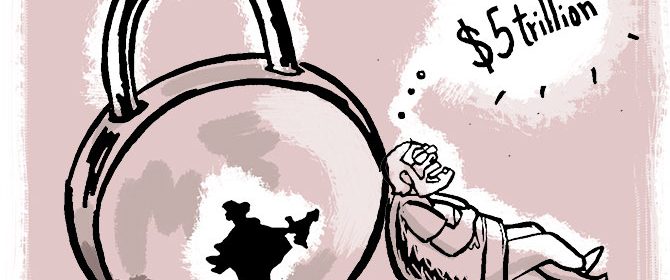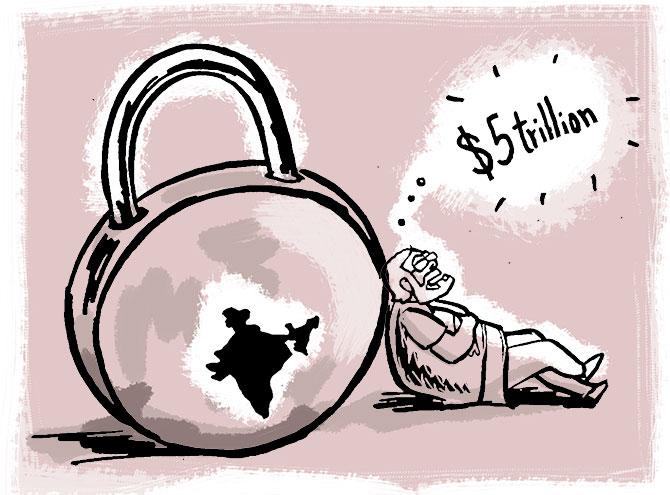When will India be a $5 trillion economy? Not before FY29, says IMF

The wait for India to become a $5-trillion economic powerhouse by 2024-25 (FY25) is going to take longer than what the finance ministry had originally intended, according to the International Monetary Fund (IMF).
The vision will instead be achieved in 2028-29 (FY29), reveals the IMF data, illustrating a four-year delay.
Chief Economic Advisor (CEA) V Anantha Nageswaran had in February said India would become a $5-trillion economy by 2025-26 or the following year, on the back of 8-9 per cent sustained growth rate in real gross domestic product (GDP).
However, the IMF data conveys that the economy will be $4.92 trillion in FY28, clearly alluding to the fact that the target will be realised in FY29.
This is notwithstanding the paring down of the real GDP growth rate forecast for India.
IMF had assigned it at 8.2 per cent, from the earlier 9 per cent for 2022-23 (FY23).
In nominal and rupee terms, the IMF projected the economy to grow 13.4 per cent in FY23 – a prognosis much higher than the Budget assumption of 11.1 per cent.
IMF seems sanguine, contrary to the Reserve Bank of India’s monetary policy committee (MPC), in envisaging economic growth.
The MPC slashed the projection for real GDP growth rate to 7.2 per cent for the current fiscal year, against the earlier 7.8 per cent.
However, with the MPC raising its estimation for the inflation rate to 5.7 per cent, from the earlier 4.5 per cent, the nominal GDP growth rate is seen at 12.9 per cent for FY23, against the earlier 12.3 per cent.
The IMF’s projection for nominal GDP growth rate (in rupee terms) will not sustain at 13.4 per cent during the years following FY23.
In fact, the projected growth rate will keep dropping each year.
It will come down to 10.6 per cent by FY28.
Says ICRA Chief Economist Aditi Nayar, “Our current projection also suggests that meeting the $5-trillion mark could get delayed to FY28 or FY29.
“This is, however, subject to the real economic growth rate, inflation rate, and the exchange rate.”
For FY23, ICRA had revised down the real GDP growth rate to 7.2 per cent, from 8 per cent, even before the MPC did, she adds.
However, the average inflation rate is likely to exceed 6 per cent.
Yet, the exchange rate may not depreciate substantially, says Nayar, adding, “Based on this, we forecast the economy to reach $3.5 trillion this fiscal year.”
However, the IMF expects the rupee to depreciate rapidly. For the current year, a dollar will mean Rs 81.5, against Rs 77.78 in the previous year.
This will go up to Rs 94.34 in FY28, highlights the data. Bank of Baroda Chief Economist Madan Sabnavis, however, concurs with the CEA.
“I will go by what the CEA had said. The reason is simple.
“While my GDP growth will be in the region of 6.5-8 per cent, high inflation will add buoyancy to our nominal GDP growth rate,” he says.
He says there was major loss due to the pandemic in 2020-21.
Whatever recovery happened has not been as sharp as one would have wanted it to and what the other countries witnessed.
“The momentum did not pick up. It is understandable because we had the second wave and our services sector faced several restrictions during a large part of the year,” says Sabnavis.
Moreover, with the Russia-Ukraine skirmish seeing little or no signs of let-up, things are further inchoate than they were before the start of the year, he adds.
“Under these conditions, the normal target of making the economy a $5 trillion in size by FY25 is definitely not achievable.
“But I believe in another two years, it will be,” he adds.
The RBI in its recent report estimates the output losses on account of the pandemic at Rs 52 trillion in the past three years. It expects economic losses to recover by 2034-35.
Source: Read Full Article

